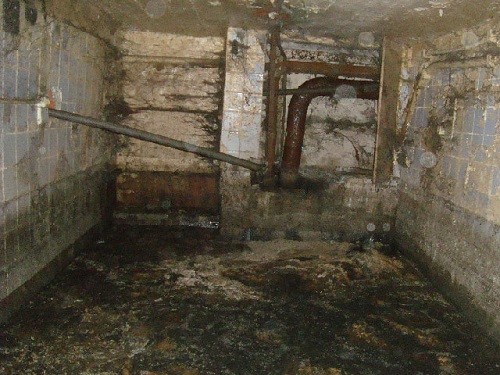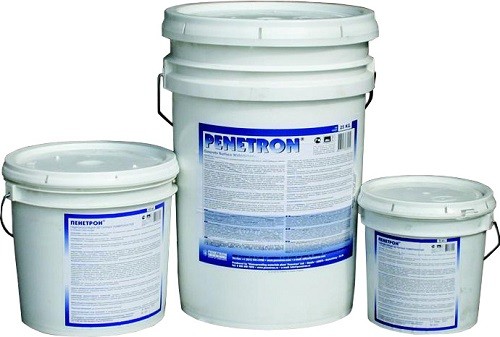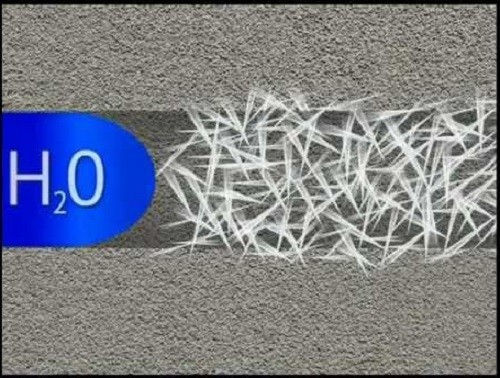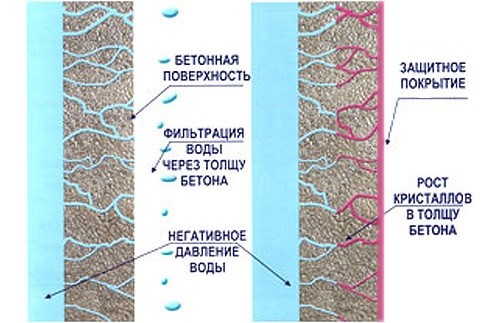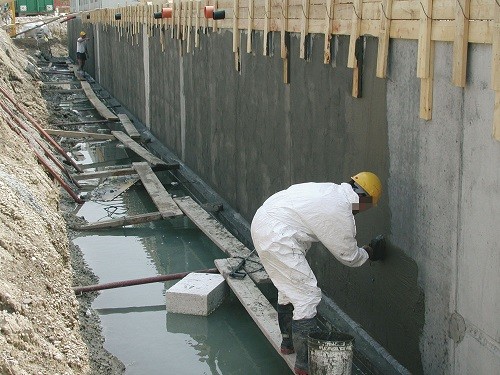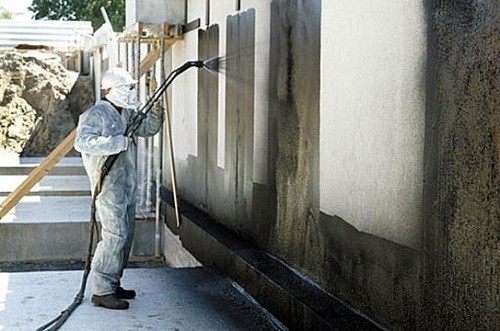
Penetrating waterproofing: characteristics and technology protection of basement Insulation

Protection of the foundation and basement from moisture guarantees the durability and good performance properties of the whole building. That is why with the slightest suspicion of excessive dampness and before the construction of a box of the house should take care of high-quality waterproofing. Today, the most popular option is the penetrating waterproofing, we will tell about in detail in this article.
Content
General characteristics of material
Today's building market we offer a wide variety of waterproofing materials for various purposes, cost, quality and service deadlines. Not so long ago, the most popular was a bitumen mastic - a cheap and durable composition, which reliably protected from moisture not only basements and foundations, but even the roofs. But progress does not stand still and the "prize of folk sympathies" switched to penetrating waterproofing.
These compositions are used to protect concrete and reinforced concrete from moisture penetration. Concrete only at first glance has a monolithic and dense structure, but in fact it is similar to a sponge with small pores through which water can penetrate. Even special waterproofing additives in the concrete mixture do not guarantee 100% blur protection, so it is necessary to carry out separate waterproofing outside and inside.
How to understand that the walls of your basement were destroyed by moisture:
- In the corners and in the area of \u200b\u200bthe plinths, black spots of mold appeared.
- Feeling increased humidity.
- The smell of dampness and sharpness appeared.
- Started plaster, wallpaper or other finish.
Traditional waterproofing materials have a lot of flaws. Thus, the inlet materials will serve as a maximum of 7-10 years, after which they will start passing water in the connection places, and the repair will have to start first. Also under rolls are often formed air bubbles, which eventually lead to the detachment of the material. The popular once bituminous mastic pretty well protected from water, but did not have due elasticity - over time she crashed and missed moisture.
Today you can find the improved compositions of bitumen mastic with special additives that give it plasticity. However, at the same time, their resistance to mechanical damage deteriorated. Working on this issue and trying to create a composition, devoid of flaws, scientists invented penetrating waterproofing.
The first to test the penetrating waterproofing of the Danes in the 60s of the last century, then the composition was tested and supplemented in other European countries, America, and as a result she reached our latitudes. Today, the market can be found a mass of brands and manufacturers, but the most proven and popular penetron (USA), Lakhta (RF), hydraulic and aquatron.
How penetrating waterproofing works
The main task of the penetrating composition is the blockage of the smallest and cracks of concrete. With such a task, only fluids cope with such a task, so the dry mixture is bred by water to a very liquid state and applied to a concrete or reinforced concrete surface with a brush, roller or mechanical sprayer.
When the mixture falls into the pores and cracks of the material, it penetrates deep inside, and then enters chemical interaction with cement. Polymers additives in its composition swell and firmly close all microscopic cavities in the wall. Thus, the surface becomes practically waterproof, and liquid waterproofing becomes part of a concrete structure, increasing its life of its operation several times.
What is good penetrating waterproofing of concrete:
- environmentally friendly material created from natural components (no health and environmental chemistry);
- can be used for waterproofing outside and inside;
- working with waterproofing is very simple (even an inexperienced builder or teenager will cope);
- film formed after drying the composition is not afraid of random mechanical damage;
- material has deep adhesion and high strength, does not penetrate and does not crack over time;
- penetrating waterproofing increases the frost resistance of concrete;
- the compositions have antibacterial effects, so they can be used in basements intended for storing food products in bomb shelters and underground warehouses.
Waterproofing basement
Finding out the principle of operation of penetrating waterproofing, it can be understood why it is so good for protecting basement and foundation. Quite often, owners of private houses face the flooding of basements after the module of snow. Spring swelling of the soil leads to deformation and destruction of the walls. To avoid this trouble, it is important to take care of the fortress of the foundation and the reliable protection of the basement at the construction stage.
Outer waterproofing
For a 100% successful result, it is necessary to conduct an outer and internal waterproofing. In this case, the basement will not be terrible soil movement still for a long time, and the house has a weight without overhaul to 70-80 years.
In most cases, a ribbon type of foundation, a monolith or collected from concrete blocks is used to build cottages and private houses. The blocks are stacked on a bulk pillow, and the joints between them become risk zones in terms of leakage and damage the basement walls.
To protect the walls of the basement outside, the deserted waterproofing of the penetrating action is used. Despite the fact that the composition was invented not so long ago, the application occurs quite the "grandfathers" method, so even an inexperienced builder will cope with it without special skills.
Progress:
- First, the basement walls are processed by primer - a mixture of gasoline and bitumen. Such a coating will provide high-quality adhesion of concrete and mastic. Primera's task is to fill all microscopic pores and cracks in cement joints.
- The primer will dry in 2-3 hours, after which you can start applying bitumen mastic. This is done with a flat construction brush.
- After applying the layer, wait 24 hours, and then cover the surface by another layer of mastic. Ideally, 2-3 layers should be made so that the total thickness of the bitumen layer was 2-3 mm. Check the thickness very simple - with the help of a stationery knife, cut a small square of the dried bitumen and measure it with a caliper.
- When the required waterproofing thickness is achieved, you can fall asleep the foundation and basement walls outside. Failure occurs in layers, and every 50 cm It is necessary to tightly till the soil.
- When 50-100 cm remains to the end, the residue of the space should be filled not to the ground, and the clay is 1.5-2 m. So you make a kind of "hydraulic scams", which will not give toal and rain waters to get to the walls of the basement from above.
Inner waterproofing
After completion of the work, the basement can be started from the inside penetrating waterproofing, and it concerns that not only the walls, but also the floor. It is held in two cases - in the process of building a house and in the case of leakage or flooding basement. We propose to disassemble the most unpleasant and problem case - the flooding of the basement.
In the case of flooding of the basement with water, the following should be taken:
- Water from the walls of the building at least 3-5 m, by pumping water with the pump.
- Examine from the basement all furniture and objects.
- Open the door to ensure maximum ventilation and can dry the room.
- In particularly serious cases, flooding can be installed in the basement the heat gun or heater so that it is faster.
- When the water goes completely, and dry the floor with the walls, you can proceed to work. For this case, penetrating waterproofing penetron is suitable - sand-cement mixture with polymer additives that quickly clog microcracks. The composition of the Lakhta brand is also very popular, which can be used both by the head of water and process the room from the inside (negative pressure).
- If the walls of the basement are covered with plaster, paint or wallpaper, they must be removed.
- Slide the surface of the bare wall with a grinder with a metal brush nozzle. So you will open the pores and cracks, which will then be filled with waterproofing.
- Deepen all the docking seams between the blocks by 2-3 cm.
- In-depth seams fill the saturated composition of waterproofing and let dry 2-3 hours.
- After the specified time on the walls and the floor, apply a liquid waterproofing composition with a wide flat brush.
- After 2-3 hours, apply a second layer of penetrating waterproofing of Lacht, Penetron or any other brand. Two layers will be enough. Similarly, you can make waterproofing the bathroom. If you use Penetron, but after applying the second layer, it is recommended to regularly spray the surface with water from the spray or tightly cover it with a polyethylene film for 10-14 days. Thus, you will create the most comfortable medium for active growth of crystals and deep penetration of polymer additives inside the concrete wall.
Before you buy penetrating waterproofing, carefully read the instructions and features of the composition of the composition, the depth of its penetration and appreciation technique. The price of the material mainly determines the depth of penetration of polymer additives. For example, a popular mixture of penetron can penetrate 50 cm deep into the concrete wall and is applied with a brush or sprayer, and the domestic hydrotect penetrates into a concrete only by 10 cm and a spatula will be useful for it to apply it.
The main advantage of the waterproofing of the penetrating action is that even newcomer can easily cope with it. Therefore, even despite the high cost, liquid compositions are gaining popularity in the global construction market.




